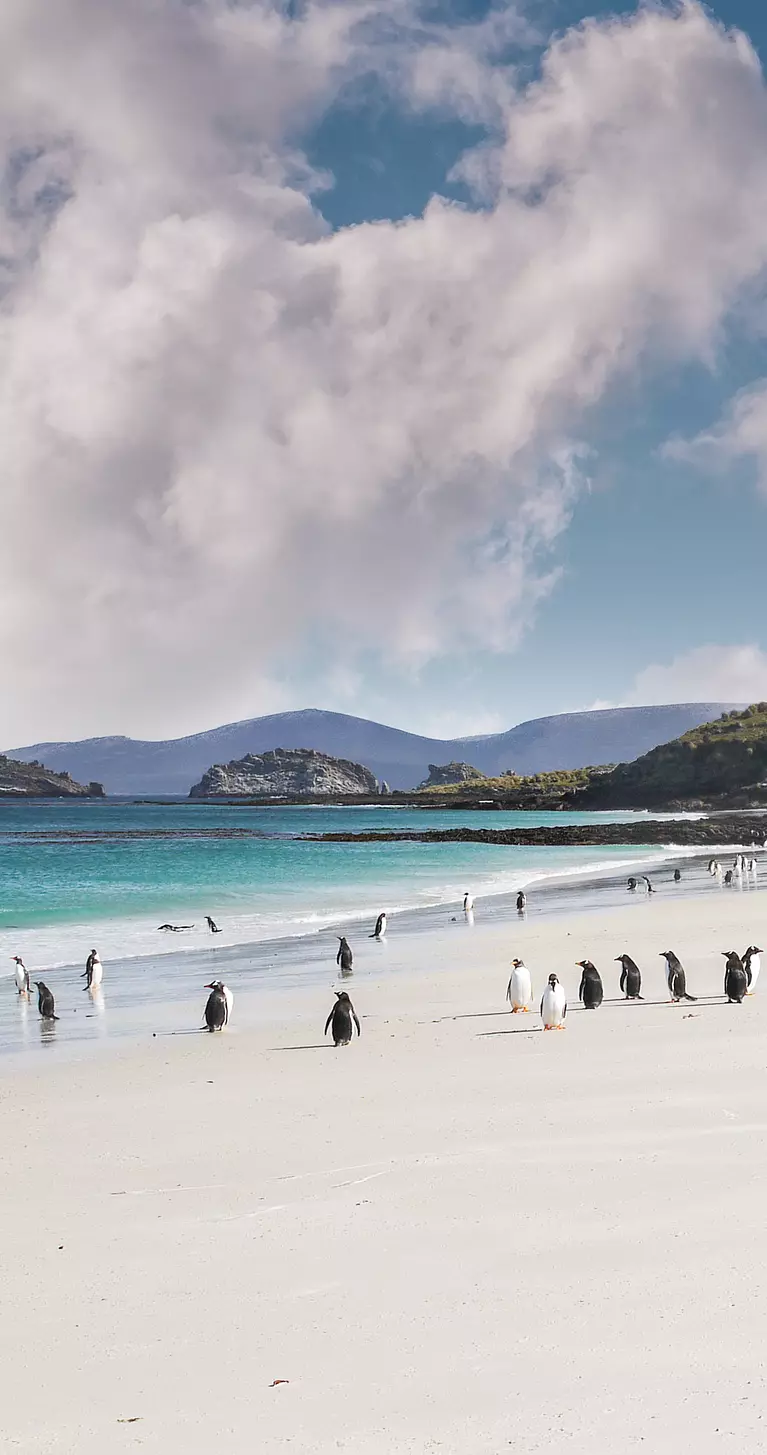No visa is required for US or Canadian citizens for short tourist visits; you’ll receive permission on arrival if you show a valid passport, onward/return ticket, and proof of funds and accommodation. Flights are limited—most travellers route via Chile—so confirm entry formalities and any transit rules with airlines before you go. Check entry updates and customs details close to departure.
Discover Tailor-Made Falkland Islands Vacations
Wildlife encounters, rugged beauty, and rich history in the remote South Atlantic.
Discover the Falkland Islands, where penguins waddle along windswept shores, seabirds wheel above dramatic cliffs, and history lingers in Stanley’s streets. This isolated archipelago offers raw natural beauty, abundant wildlife, and a fascinating cultural mix for adventurous travellers.
Featured Highlights
- View thousands of penguins in their natural rookeries
- See elephant seals, sea lions, and rare seabirds
- Explore Stanley’s historic pubs and maritime heritage
- Wander open trails with sweeping South Atlantic views
- Experience a unique blend of British and island culture
- Find peace in remote, windswept, unspoiled landscapes
What do Goway's travellers say?

Get to know Falkland Islands before you go.
Best Time to Visit
The Falkland Islands change character with every season, offering travellers a choice of experiences shaped by wildlife, landscapes, and culture. Whether you are drawn by penguins, sweeping skies, or local traditions, the timing of your journey can transform your encounter with this remote South Atlantic archipelago.
From November to March, the Falklands’ summer is alive with activity. Vast penguin colonies, breeding seabirds, and playful seal pups provide endless fascination for wildlife lovers. The longer daylight hours invite extended hikes, photography sessions, and coastal explorations, all in relatively mild weather. For birdwatchers, this is also the height of migratory arrivals, making it a rewarding time to visit.
April and October bring a quieter charm. These shoulder months are perfect for travellers seeking solitude, offering shifting light and striking seasonal transitions. Landscapes take on moody hues, and wildlife behaviour subtly changes, creating new opportunities for photographers and nature enthusiasts alike.
The islands’ winter, from May to September, reveals a different rhythm. Orcas and humpback whales can often be spotted offshore, while the long nights provide exceptional conditions for stargazing beneath Southern Hemisphere constellations. Fewer visitors mean a more personal atmosphere, with the added benefit of reduced travel costs.
Birdwatching remains a year-round highlight, as resident and migratory species ensure there is always something remarkable to observe. For those interested in local culture, timing a visit around 14 June allows you to join islanders in celebrating Falkland Islands Day, a festival of heritage, parades, and community pride. Whether for wildlife, photography, or cultural connection, every season in the Falklands offers its own unforgettable rewards.
Frequently Asked Questions
Do I need a visa or special permits to enter Falkland Islands?
What language is spoken locally? How widely is English understood in Falkland Islands?
English is the official language and is spoken everywhere. You’ll also hear some Spanish due to links with Chile and other South American neighbours, but you can comfortably travel using English.
What are the must-see attractions in Falkland Islands?
Start in Stanley for the Christ Church Cathedral and its photogenic Whalebone Arch, then head to Gypsy Cove for Magellanic penguins minutes from town. Wildlife lovers should island-hop: Volunteer Point (king penguins), Sea Lion Island (elephant seals, orcas), West Point and Carcass/Saunders for rockhoppers and black-browed albatross. Goway features wildlife-focused stays and day trips that bundle these highlights.
Is Falkland Islands safe? What should I keep in mind while travelling there?
Crime is very low; most risks come from nature. Weather flips quickly—strong winds, cold, and rough seas—so dress for four seasons in a day and watch conditions. Respect wildlife distances (about 6 m/20 ft) and never block animals’ route to the sea. Although mine clearance finished in 2020, unexploded items can occasionally be found—stay on marked paths and heed any signage. Photography at Mount Pleasant Airport is restricted. Always confirm local advisories before excursions.
What’s the best way to travel within Falkland Islands?
Distances are big, roads are mostly gravel, and conditions can be rough. Travellers typically combine short inter-island flights on FIGAS (a book-as-you-go “air taxi”) with 4x4 transfers. FIGAS publishes next-day times each afternoon; weather can affect routes, so build in buffer time. If you self-drive, keep speeds down on gravel and let locals pass. Goway itineraries usually include flights and transfers to keep things seamless.
What Falkland Islands cultural customs should I be aware of?
Island life is friendly and informal—greet people, hold doors, and expect lots of polite small talk. British traditions (tea, pubs, rugby/cricket chat) run strong. In the countryside, ask before crossing private land, close gates, and follow the local Countryside Code around wildlife.
What should I wear/pack for Falkland Islands’ climate?
Think wind first, then cold. Pack breathable layers: thermal base layers, fleece or wool mid-layers, a windproof/waterproof shell, warm hat, neck gaiter, gloves, and sturdy waterproof hiking boots. Add sunglasses for blowing sand at beaches, a dry bag for gear on small planes/boats, and a long lens for wildlife so you can keep your distance. Summer highs hover around 10–13°C; winters feel near-freezing with frequent gales—so year-round, layers win.
Unlock more by subscribing to our newsletter
With our newsletter, you’ll get access to regular communications that inspire you and help you explore the world your way